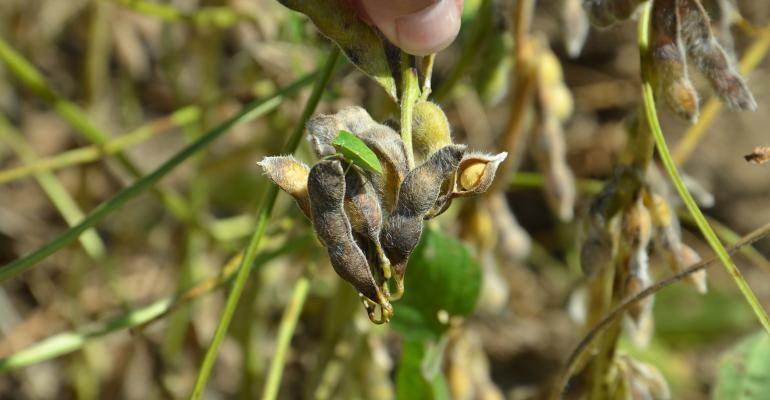Don't rule out late application for stinkbugs

Soybean Pest Beat: Stinkbugs can cause economic loss all the way to harvest if left unchecked.
Jul 04, 2019
It seems silly to spray for stinkbugs if they show up when the crop is almost finished. Are there any situations where it would pay to spray soybeans mid-August or later? How can I determine if I would see a positive return on investment?
The Indiana certified crop adviser panel answering this question includes Jamie Bultemeier, A&L Great Lakes Labs, Fort Wayne; Troy Jenkins, agronomist with Ceres Solutions, Rochester; and Marty Park, Great Lakes Seed Service, Rensselaer.
Bultemeier: Stinkbug damage is possible anytime pods are green, and seeds continue to develop through the month of August. That will likely continue into September this year. Late-planted and full-season beans can have green pods, especially at the top of the plant and when late rains are plentiful.
Stinkbug feeding can greatly reduce seed quality, along with reducing seed weight and yield. Soybeans for seed or specialty contracts are at a greater risk from stinkbug damage. Those uses place an even higher premium on quality and no damage or disease.
Utilizing a sweep net is the best scouting method for stinkbugs. For commercial soybeans, 40 stinkbugs per 100 sweeps while the pods are green is the threshold for insecticide treatment. For seed and specialty soybeans, 20 stinkbugs per 100 sweeps while the pods are green is the threshold for insecticide treatment. A wise management tool for making any decisions is to leave an untreated check in the field, assuming you do spray for stinkbugs, to compare yield at the end of the season to verify the effect of the decision.
Jenkins: Green stinkbugs can cause devastation to soybean fields from flowering to harvest. The major yield reduction is attributed to flower abortion, pod abortion and soybean grain quality. Stinkbugs’ piercing mouth parts puncture soybean pods and suck nutritional fluid from the bean. Both nymphs and adults feed on soybeans and cause great economic damage when insect populations are above threshold levels.
In commercial soybean production fields with green soybean pods, sweep 20 times in five field areas. Insecticide application would be recommended if there is an average of 0.4 stinkbug per sweep. In seed production fields, the threshold number is 0.2 stinkbug per sweep.
Park: In 2018, we saw yield loss and compromised grain quality because of stinkbugs. Some growers even got docked at the elevator for damage that started with stinkbugs and was enhanced by the late, wet fall harvest. So, I would be on the lookout for this pest in 2019, especially with all the late-planted soybeans.
The threshold for an insecticide application is one stinkbug per foot of row, or 3.6 stinkbugs per 15 sweeps with a sweep net. The thresholds are lower for seed production fields.

